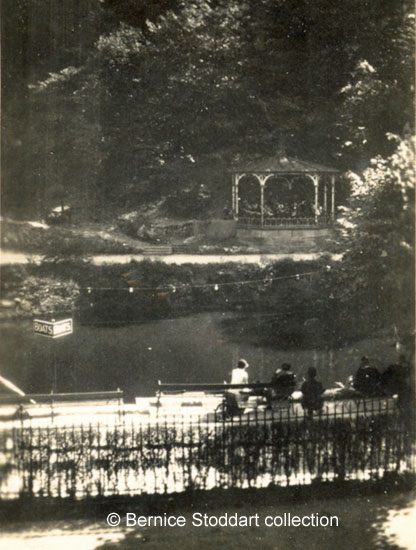|
Images Index> Matlock Bath, 20th and 21st Century Images> This page |
| Matlock Bath: Lovers' Walks and the Band Stand |
| Matlock Bath : Twentieth Century Photographs, Postcards, Engravings & Etchings |
|
|||||||||||||||||||||||
The Military Band wasn't the first band in Matlock Bath, nor would it be the last. As early as 1863 a band from the village competed in a brass band contest at Crystal Palace. Twenty one bands took part and the third prize, of 15l. (£15), was awarded to the Matlock Bath group[7]. Twenty years later Matlock Bath had a Quadrille Band[8] and shortly afterwards Mr. Barnes's Matlock Bath Orchestral Band were performing locally[9]. In 1903 the Royal Italian Military Band performed in the village throughout the season and then extended their stay for a further two or three weeks longer than normal before heading for South Africa[10]. This was the band that first brought Romolo Tinti, a young man from Bologna in Italy, to Matlock Bath[11]. Its conductor was Signor Emanuele Guidi and the band was made up of nine men, playing two cornets, two clarionettes, two trumpets, an euphonium, bombardine and drums[12]. They gave three performances here daily. Brass Band music is, of course, still enjoyed today. But in September 1914 the Bandstand was used for a different purpose. Frederic Arkwright addressed a
public meeting from its stage in support of Lord Kitchener's demand for men in a heartfelt plea to persuade
more men from the locality to join up. Nineteen men from Matlock Bath had already done so and Mr. Arkwright
told the assembled crowd that he had one son already at the front, whom he hadn't heard from for
a fortnight, and the other was in the Derby Recruiting office; the latter was signing 1,150 recruitment forms
each day. He just wished he (Frederic) were 20 or 30 years younger as he would have been amongst those
volunteering[13].
|
|||||||||||||||||||||||
1. "Promenade & Lovers Walks, Matlock Bath". No.35525. Postcard in the collection of and provided by and © Ken Smith. 2. Hardstaff family photograph, © Bernice Stoddart collection. Images scanned for this website and information researched by and © Ann Andrews. Intended for personal use only. |
|||||||||||||||||||||||
|
[1] "Derby Daily Telegraph" 4 September 1905. [2] Bryan, Benjamin (1903) "History of Matlock - Matlock, Manor and Parish" London by Bemrose & Sons, Limited. [3] "The Derby Mercury", Wednesday, June 22, 1892. See Matlock Bath & Scarthin Newspaper Cuttings, 1892. [4] "ibid.", Wednesday, 5 July 1893. Matlock Bath. Public Improvement. [5] "ibid.", Wednesday, May 16, 1894. [6] "Derbyshire Times", 9 June 1894. His decision was reached mostly because of the opposition of the Wesleyans, whose chapel was almost directly opposite the bandstand. Arkwright had also received strong objections from the Church of England and the Congregationalists. [7] "The Derby Mercury", Wednesday, August 5, 1863. [8] "ibid.", Wednesday, December 26, 1883. Report of Matlock Bath's Quadrille Band playing at Fritchley. [9] "ibid.", Wednesday, November 17, 1886. [10] "Derbyshire Courier", 19 September 1903. Romolo Tinti married the same year and went with this band to South Africa (this last from family members). [11] "Derbyshire Times", 26 April 1940. Mr. Romolo Tinti. Death of Matlock Bath tradesman. [12] "ibid", 27 June 1903. [13] "Derbyshire Advertiser and Journal", 11 September 1914.
Matlock Bath War Meeting. |
|||||||||||||||||||||||























